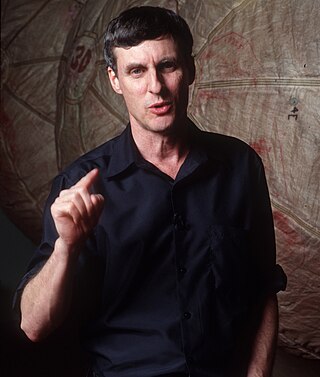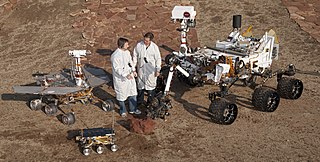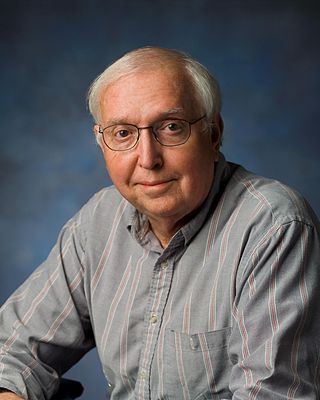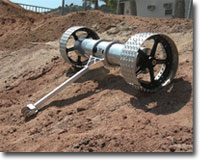
Steven Weldon Squyres is an American geologist and planetary scientist. He was the James A. Weeks Professor of Physical Sciences at Cornell University in Ithaca, New York. His research area is in planetary sciences, with a focus on large solid bodies in the Solar System such as the terrestrial planets and the moons of the Jovian planets. Squyres was the principal investigator of the Mars Exploration Rover Mission (MER).

Harold (Hal) Masursky was an American astrogeologist.
The Lunar and Planetary Institute (LPI) is a scientific research institute dedicated to study of the solar system, its formation, evolution, and current state. The Institute is part of the Universities Space Research Association (USRA) and is supported by the Science Mission Directorate of the National Aeronautics and Space Administration (NASA). Located at 3600 Bay Area Boulevard in Houston, Texas, the Institute serves as a scientific forum attracting visiting scientists, postdoctoral fellows, students, and resident experts; supports and serves the research community through newsletters, meetings, and other activities; collects and disseminates planetary data while facilitating the community's access to NASA astromaterials samples and facilities; engages and excites the public about space science; and invests in the development of future generations of scientists. The LPI sponsors and organizes several workshops and conferences throughout the year, including the Lunar and Planetary Science Conference (LPSC) held in March in the Houston area.

Philip Russel Christensen is a geologist whose research interests focus on the composition, physical properties, processes, and morphology of planetary surfaces, with an emphasis on Mars and the Earth. He is currently a Regents' Professor and the Ed and Helen Korrick Professor of Geological Sciences at Arizona State University (ASU).

Maria T. Zuber is an American geophysicist who is the E. A. Griswold Professor of Geophysics at Brown University and a current trustee. Zuber has been involved in more than half a dozen NASA planetary missions aimed at mapping the Moon, Mars, Mercury, and several asteroids. She was the principal investigator for the Gravity Recovery and Interior Laboratory (GRAIL) Mission, which was managed by NASA's Jet Propulsion Laboratory.

James F. Bell III is a professor of Astronomy at Arizona State University, specializing in the study of planetary geology, geochemistry and mineralogy using data obtained from telescopes and from various spacecraft missions. Bell's active research has involved the NASA Mars Pathfinder, Near Earth Asteroid Rendezvous (NEAR), Comet Nucleus Tour (CONTOUR), 2001 Mars Odyssey, Mars Reconnaissance Orbiter, Lunar Reconnaissance Orbiter, and the Mars Science Laboratory missions. His book Postcards from Mars includes many images taken by the Mars rovers. Bell is currently an editor of the space science journal Icarus and president of The Planetary Society. He has served as the lead scientist in charge of the Panoramic camera (Pancam) color imaging system on Mars rovers Spirit and Opportunity.

A rover is a planetary surface exploration device designed to move over the rough surface of a planet or other planetary mass celestial bodies. Some rovers have been designed as land vehicles to transport members of a human spaceflight crew; others have been partially or fully autonomous robots. Rovers are typically created to land on another planet via a lander-style spacecraft,tasked to collect information about the terrain, and to take crust samples such as dust, soil, rocks, and even liquids. They are essential tools in space exploration.

David Stewart McKay was chief scientist for astrobiology at the Johnson Space Center. During the Apollo program, McKay provided geology training to the first men to walk on the Moon in the late 1960s. McKay was the first author of a scientific paper postulating past life on Mars on the basis of evidence in Martian meteorite ALH 84001, which had been found in Antarctica. This paper has become one of the most heavily cited papers in planetary science. The NASA Astrobiology Institute was founded partially as a result of community interest in this paper and related topics. He was a native of Titusville, Pennsylvania.

The Mars Exploration Joint Initiative (MEJI) is an agreement signed between United States' space agency, NASA, and Europe's space agency, ESA to join resources and expertise in order to continue the exploration of the planet Mars. The agreement was signed in Washington D.C. in October 2009, between NASA administrator Charles Bolden and ESA director-general Jean-Jacques Dordain.

The Planetary Science Institute (PSI) is a 501(c)(3) non-profit research institute based in Tucson, Arizona, focusing on planetary science. As of 2018, its director is Dr. Mark V. Sykes. PSI, along with Space Science Institute (SSI) Southwest Research Institute (SwRI), and Eureka Scientific, were listed as 501(c)(3) organizations in the US in a special report by Nature in 2007, which facilitate federal grant applications of non-tenure-track astronomers.

Curiosity is a car-sized Mars rover exploring Gale crater and Mount Sharp on Mars as part of NASA's Mars Science Laboratory (MSL) mission. Curiosity was launched from Cape Canaveral (CCAFS) on November 26, 2011, at 15:02:00 UTC and landed on Aeolis Palus inside Gale crater on Mars on August 6, 2012, 05:17:57 UTC. The Bradbury Landing site was less than 2.4 km (1.5 mi) from the center of the rover's touchdown target after a 560 million km (350 million mi) journey.

Jessica Andrea Watkins is an American NASA astronaut, geologist, aquanaut and former international rugby player. Watkins was announced as the first Black woman who completed an International Space Station long-term mission in April 2022. On June 9, 2022, at 7:38 UTC, she became the African American woman with the most time in space, surpassing Stephanie Wilson's 42 day, 23 hour and 46 minute record.

Tanya Harrison is a planetary scientist who was until March 2023 a manager of science programs at Planet Labs, working in their federal arm with science agencies to increase research use of Planet Labs' Earth observing satellite data. Previously, Harrison was the director of research at Arizona State University's Space Technology and Science Initiative, and was on the science team of the Mars Opportunity and Curiosity rovers.

Sarah Milkovich is lead of Science Operations for the Mars 2020 rover at Jet Propulsion Laboratory. She was investigation scientist for the HiRISE camera on the Mars Reconnaissance Orbiter.

Barbara Cohen is a planetary scientist at NASA's Goddard Space Flight Center. The asteroid 6816 Barbcohen is named after her.

Bethany List Ehlmann is an American geologist and a professor of Planetary Science at California Institute of Technology. A leading researcher in planetary geology, Ehlmann is also the President of The Planetary Society, Director of the Keck Institute for Space Studies, and a Research Scientist at NASA's Jet Propulsion Laboratory.

Moon Diver is a proposed lunar mission concept by NASA's Jet Propulsion Laboratory that would employ a robotic lander and a – distant coaxial – two-wheeled rover called Axel to investigate the exposed geological layers on the walls of a deep lunar pit.
Melinda Darby Dyar is a planetary geologist, mineralogist, and spectroscopist whose research relates to the evolution of the Solar System. She studies the redox state of iron and the abundance of hydrogen using Mössbauer, x-ray absorption, and FTIR spectroscopy in the Solar System planets, specifically Earth, Moon, Mars, Mercury, and Venus.

The NASA-ESA Mars Sample Return is a proposed Flagship-class Mars sample return (MSR) mission to collect Martian rock and soil samples in 43 small, cylindrical, pencil-sized, titanium tubes and return them to Earth around 2033.
Kathryn Stack Morgan is scientist at the National Aeronautics and Space Agency where she is known for her work in the exploration of planets such as Mars.


















